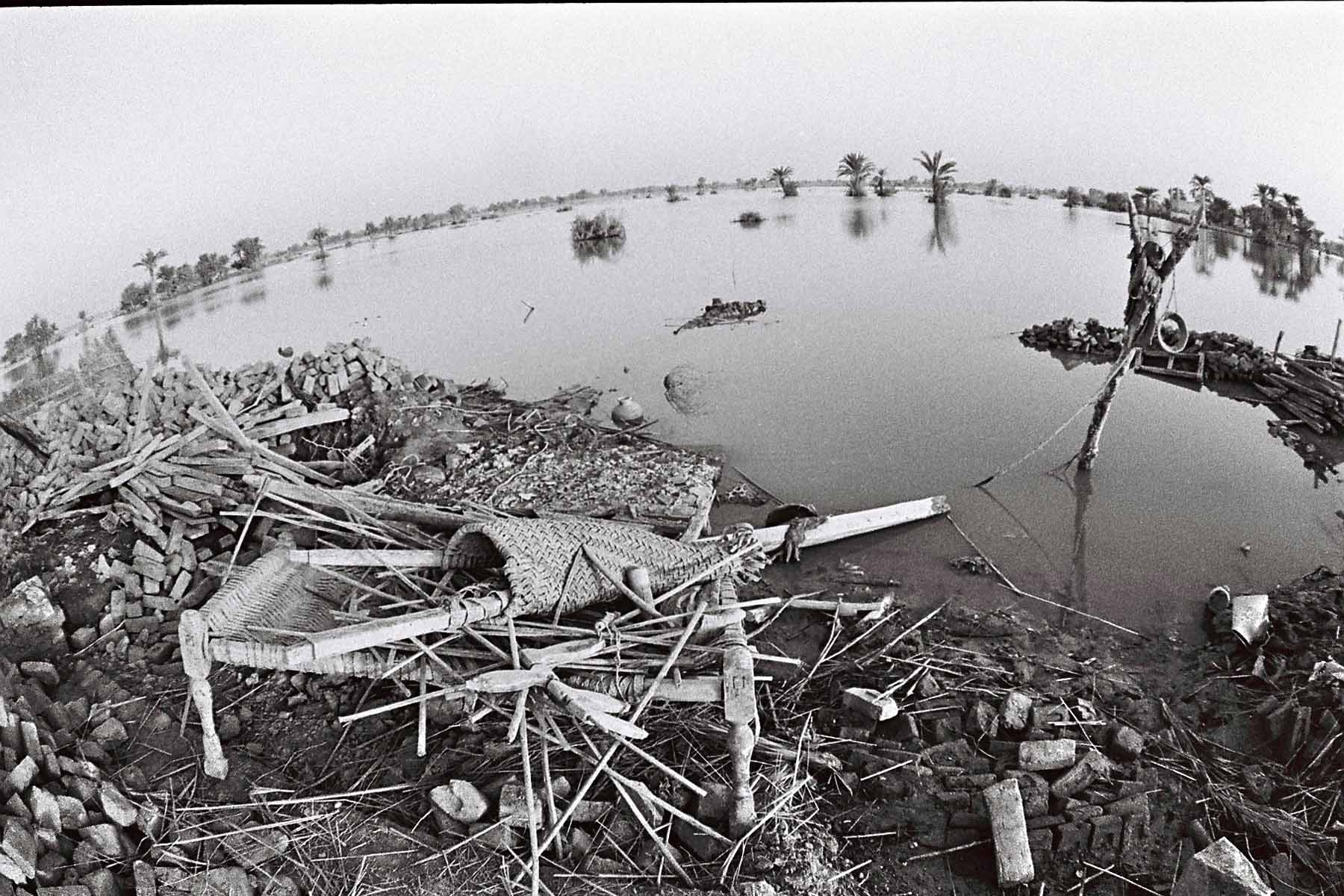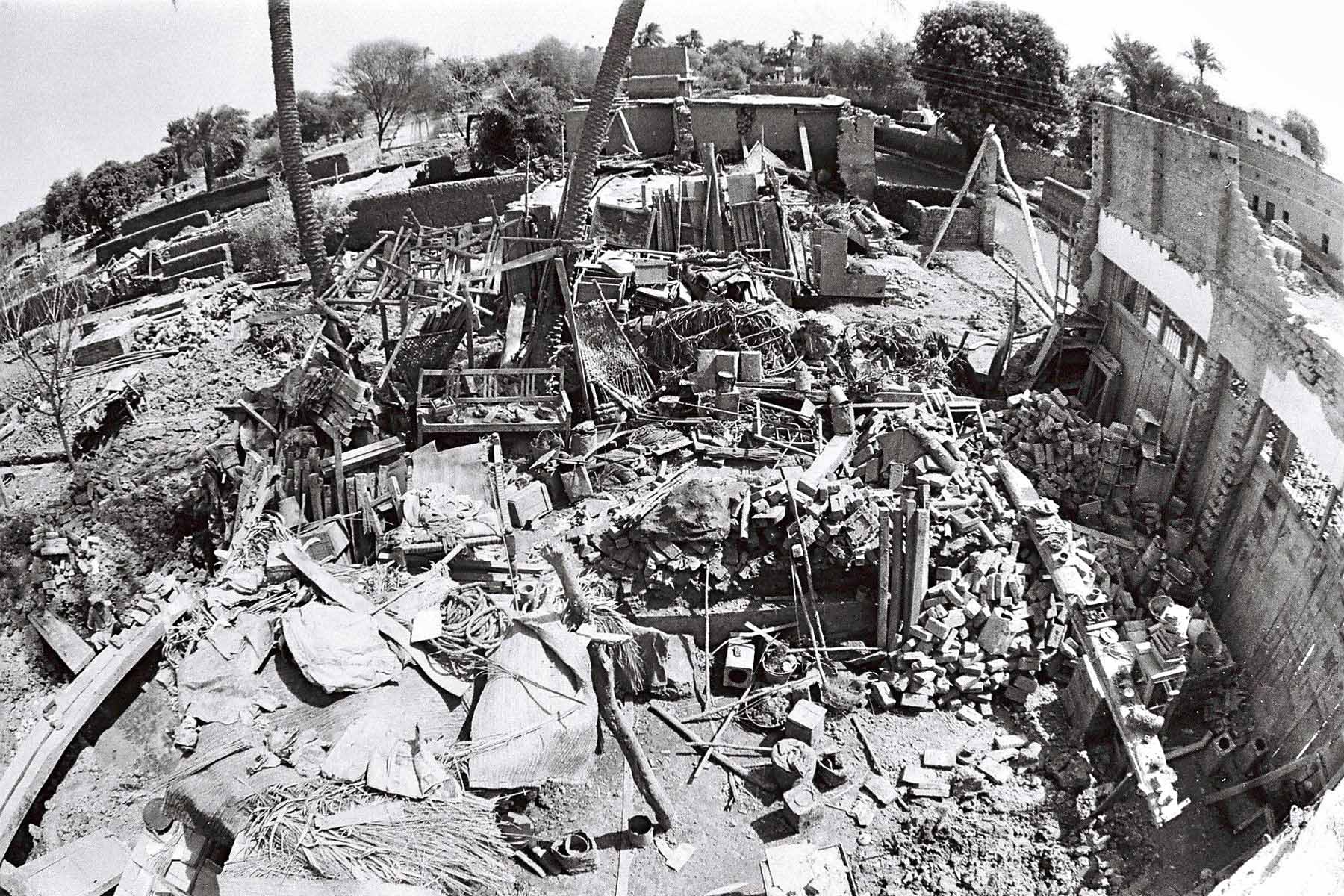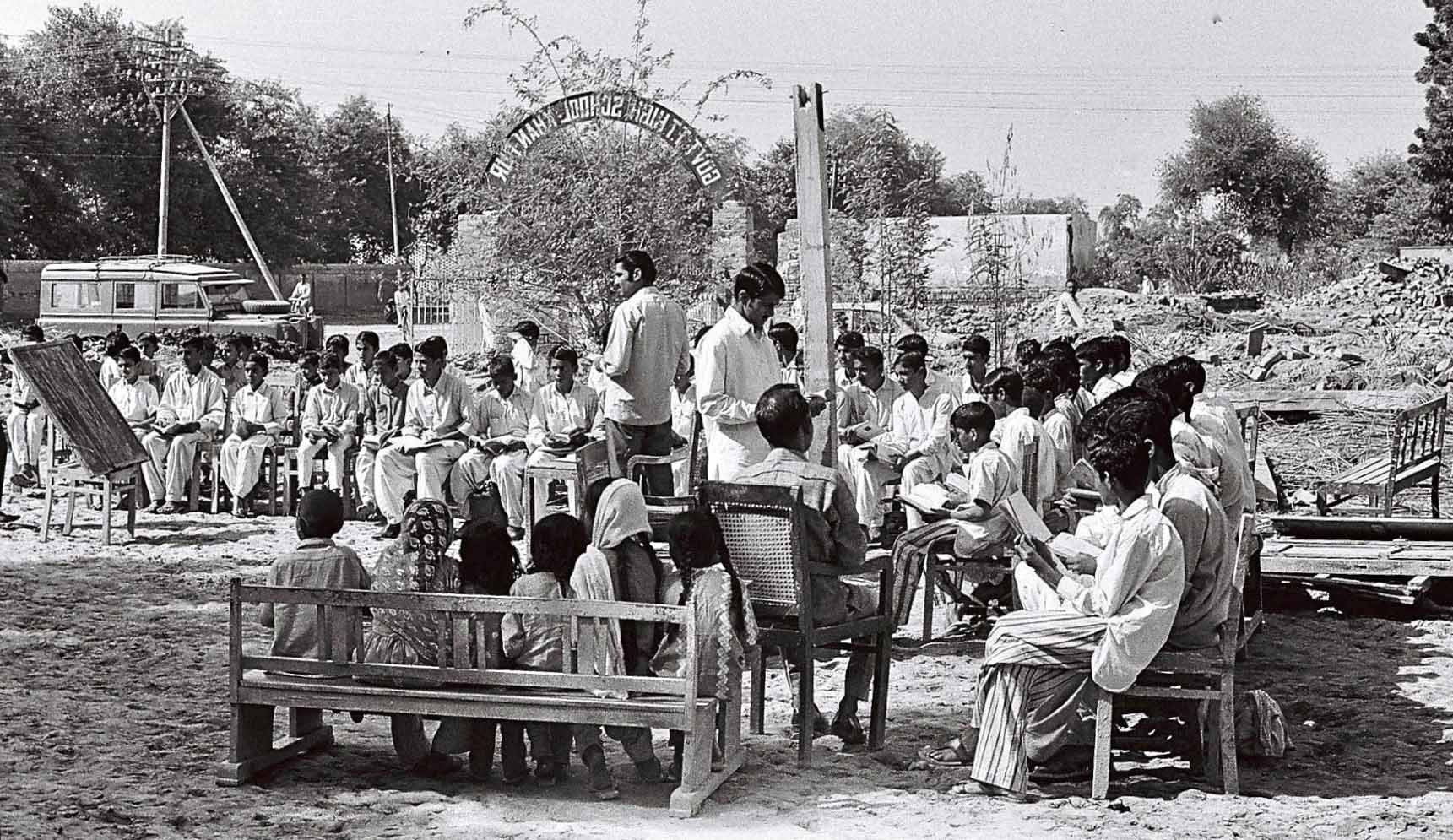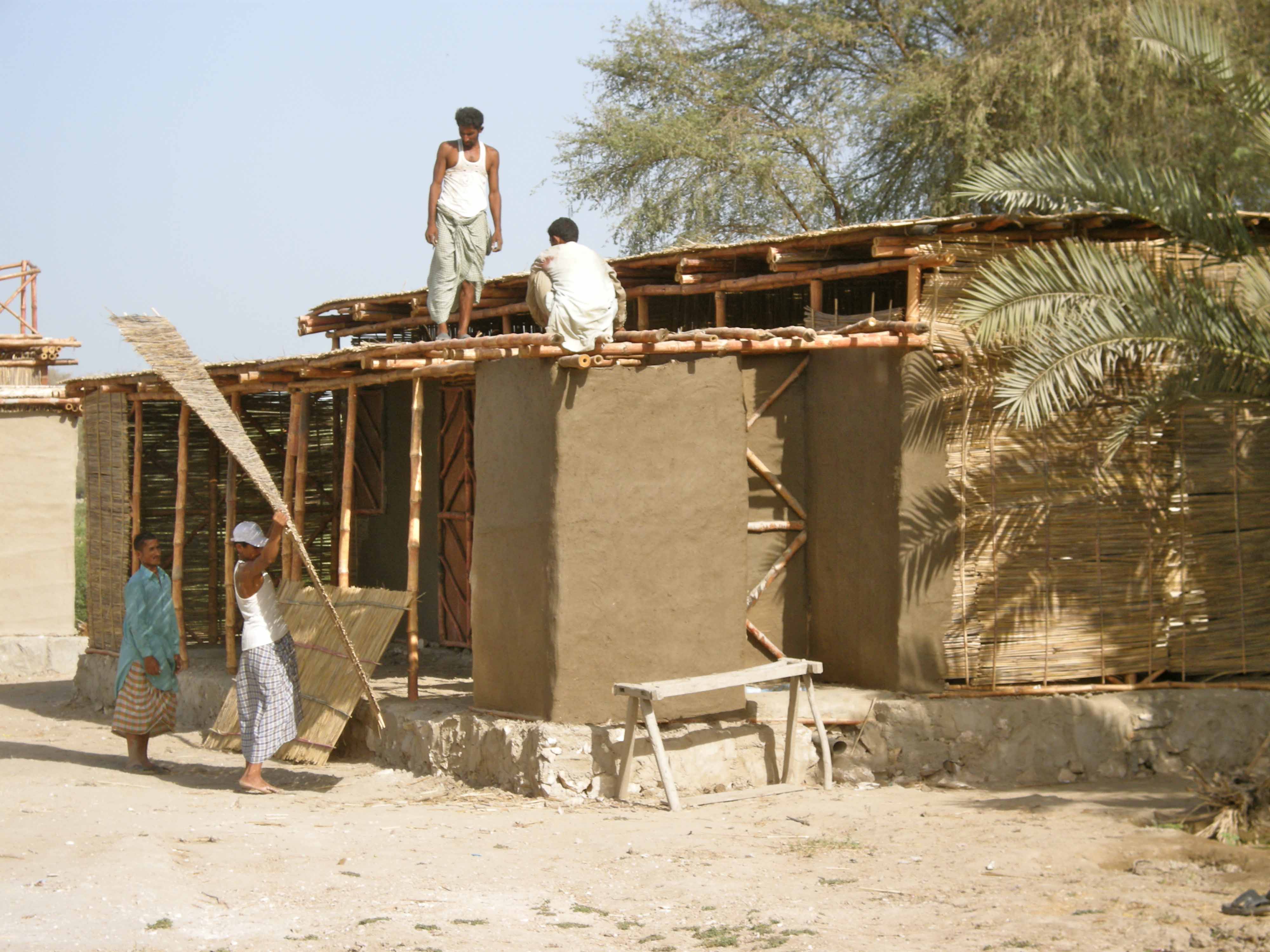Flood
After news regarding the havoc caused by the floods was reported, the programme for the relief of Swat was undertaken almost immediately by Mrs Lari of the Heritage Foundation of Pakistan. Her first batch of food to 30 families, equal to approximately 5,000 meals, was delivered on 10th August in Mingora, which was among the most badly affected areas. The next batch consisting of rations sufficient for over 22,000 meals, was delivered on 15th August and was delivered to families in Marghazar, a remote locality close to the handloom centre of Islamapur, where almost all the houses had been swept away or damaged by lightning. Another batch of food packages for 150 families was delivered on 21st August to the families in Zahidabad, Akhtarabad and to a locality known as Bangladesh.
A piece of land was selected in Marghazar, in the vicinity of a school building and close to a small army chowki run by a young lieutenant of the Pakistan Army, who provided full cooperation during the visits of Heritage Foundation teams. The DCO (District Coordinating Officer) of Swat, Atif Rehman, visited the site and appreciated the design of the Green KarvanGhar, which he said blended well with the environment. Positive feedback was received from the community members who kept on visiting the demo unit and showed keenness to begin construction. The DCO, General Ramday, invited Mrs Lari to proceed with building houses for the flood-affected families. The Corps Commander, Khyber Pakhtunkhwa, visited the first one built in Matta on 25th September, along with the GOC and other Pakistan Army officers. After the approval, work on 200 units began in dispersed villages located in the mountains of Swat. The funding for these units was provided under a Scottish International Development grant secured by Professors Peter and Azra Meadows of Glasgow University. A visit from Justice Nasira Javed to the Koray camp was much welcomed as she surveyed the work being undertaken. Two Green Women’s Centres were constructed, one in Biha and another in Koray. The site for the Biha GWC was along the main road to provide easy access to all women in nearby areas. Meanwhile, at the Koray Camp, specifically designed to house a cluster of 12 families, the Green Women’s Centre was situated in the centre. The strategic placement of the Green Women Centres in Swat was of importance not only due to the difficult terrain and accessibility, but also to ensure that when women visited the centres they could bring along children who could play in the nearby open area. This ensured that the women could work and interact without having to worry about their offspring.
When Sindh was affected by floods in 2010, Mrs. Lari was asked by the Nazim of Khairpur, Ms. Nafisa Shah, to help people there. To begin with the Heritage Foundation helped build the village of Darya Khan Shaikh with a cluster of 55 houses in katcha (area close to the river which is prone to annual flooding), 30 km from Khairpur City, but when she invited Ms. Nafisa Shah, she said that it was in Pir jo Goth or Pir Saheb’s area, therefore the Heritage Foundation took up the work in another village, and both the villages have survived subsequent rains and floods. The two villages were developed through funding received from the Swiss Pakistan Society. The Heritage Foundation has also built a park for green construction in the vicinity of the great Kot Diji Fort, named Sayani DRR Park, after Ms. Safeeya Moosa’s family who provided the funding from South Africa. The Heritage Foundation also took up the restoration of the old granary in Khairpur with funding secured from the Prince Claus Fund. In all this the Heritage Foundation had the support of a resident of Khairpur who happened to be the DCO at the time, and later Commissioner of Sukkur, Abbas Baloch.
One day Paras, a daughter of our old friend Ms. Mumtaz Rashidi, came with her husband, Mehmood Shah, to ask my wife to help people in their village Moak Sharif in Tando Allahyar, affected by rains and floods. The Heritage Foundation team set up a base camp in the village and began to help build almost 300 shelters. At the same time my wife devised the program ‘Build Back Safer with Vernacular Methodologies’ and DRR (Disaser Risk Reduction)-compliant earth, lime and bamboo shelters, known as KaravanGhar, which received support from DFID and IOM. As technical partners of IOM, the Heritage Foundation of Pakistan trained their implementation teams and went out to help build, teach and monitor over forty thousand houses in over fifteen hundred villages according to Yasmeen’s zero carbon footprint design; whereas politicians have been building them at ten times the cost, increasing carbon emission and denuding Pakistan of forest cover for decades to come. The Heritage Foundation of Pakistan also helped villagers to build thousands of zero carbon footprint smokeless chulahs and latrines designed by Yasmeen and Swiss volunteer, Saad. Several schools and community centres following the principle of zero carbon footprint were also built in a large number of villages in Sindh.
When UNDP became interested in conducting a program for youth engagement in the conservative and Taliban affected area of Dera Ismail Khan, their representative visited the Heritage Foundation of Pakistan offices to have a discussion with Mrs. Lari. They were facing difficulties because of reduced funding and wondered if her low cost methodology using sustainable materials could be used to build these centres. She suggested the training of local youth in building zero carbon structures using earth, lime and bamboo. It was thus, that the work was undertaken in the remote villages of Dera Ismail Khan.
While working in the field Ms. Lari has encountered abject poverty and illiteracy in villages of Sindh, but the situation in villages of KPK was much worse. They did not even have clean water to drink and even her hardened village artisans from Sindh, who had been sent as trainers, began to fall ill. For decades the communities had been forced to use dirty rainwater collected in makeshift ponds. As the only tube well belonged to the landlord who allowed water from it to villagers only once a week. Therefore she had first to provide them with clean water, which was struck at 350 feet. The inaccessible roads and remoteness of the area was challenging but the work was accomplished on a sharing basis with one third being the community share of the cost.
The zero carbon training programs was extended to many other youngsters in the surrounding community and work began on bamboo prefab structures comprising emergency shelters and toilets, which Ms. Lari had designed as an alternative to tents. The first attempt was to send them to villages in Chitral. But in view of the difficulties in delivery due to the closure of the Lowari Tunnel only ten prefabricated units could be delivered in Chitral. The remaining 140 units prefabricated by DI Khan trainees with support from UNDP were sent to Dir and Shangla. Before that we had seen the prime minister on TV distributing cheques at a gatherings in Shangla, and saying that an inventory of everyone affected by the earthquake had been made, and that he had come to distribute cheques from funds donated by the Government of KP and the Federal government. But in the villages where Heritage Foundation staff and volunteers went it was reported that they had not received any help of any kind from anyone.
This is the case all over the subcontinent, where neither politicians, nor the bureaucracy nor the media cares about or visits villages where poverty and illiteracy prevail, and there is no clean water to drink, no latrines and no accommodation fit for their stay. However the world couldn’t ignore her work for long, thanks to the Internet which carried the website of the Heritage Foundation. In order to prove that Yasmeen’s low cost low carbon mud houses could withstand earthquakes, it was decided to prove that non-engineering structures, if designed carefully can be seismic resistant. A test at NED College Laboratory was conducted in the presence of the vice chancellor himself and representatives of international agencies, and it was found that Mrs Lari’s designed earth, lime and bamboo structures with engineering input from Engr. Amin Tariq could withstand over twice the intensity of the Kobe earthquake in Japan, without showing any damage to the structure. At the shaking table experiment every attempt to demolish the structure by taking the movements upto 670% of Kobe earthquake failed to collapse the structure, thus proving the life safety attributes of Mrs. Lari’s zero carbon structures.
Mrs. Lari’s work was filmed by a prize-winning Indian film maker named Faiza, and repeatedly broadcast by Aljazera TV in their series on rebel architecture. Safeeyah Moosa of South Africa sent a photographer to film her work and broadcast it on TV stations in South Africa to collect funds for the Heritage Foundation of Pakistan’s work. The foundation received generous awards for their work from organizations like the Islamic Development Bank which was given at Dushanbe, the capital of Tajikistan, to which we sent our director Shanaz Ramzi.
The Heritage Foundation of Pakistan chief executive Yasmeen Lari is the only Pakistani architect whose work has been exhibited from January to April 2016 by the Royal Institute of British Architects (RIBA), and she was invited by them to lecture and conduct a workshop in London on how to work with sustainable materials with low/zero carbon footprint.
Meanwhile, Phaidon Press Limited of Regent’s Wharf, All Saints Street, London, and 180 Varick Street New York NY 10014, published an encyclopedia of the 20th Century World Architecture built between 1900 and 1999, in 97 countries of the world, comprising every imaginable building type, from the smallest single houses, cafes and zoo structures to huge utopian housing projects, centres of government, and new universities. The experts from the building industry chose 757 examples of the most outstanding work done during the twentieth century, from a selection made by over 150 specialist advisors from every geographical region of the world. One of the works selected was our house in Karachi, designed by Yasmeen Lari.




